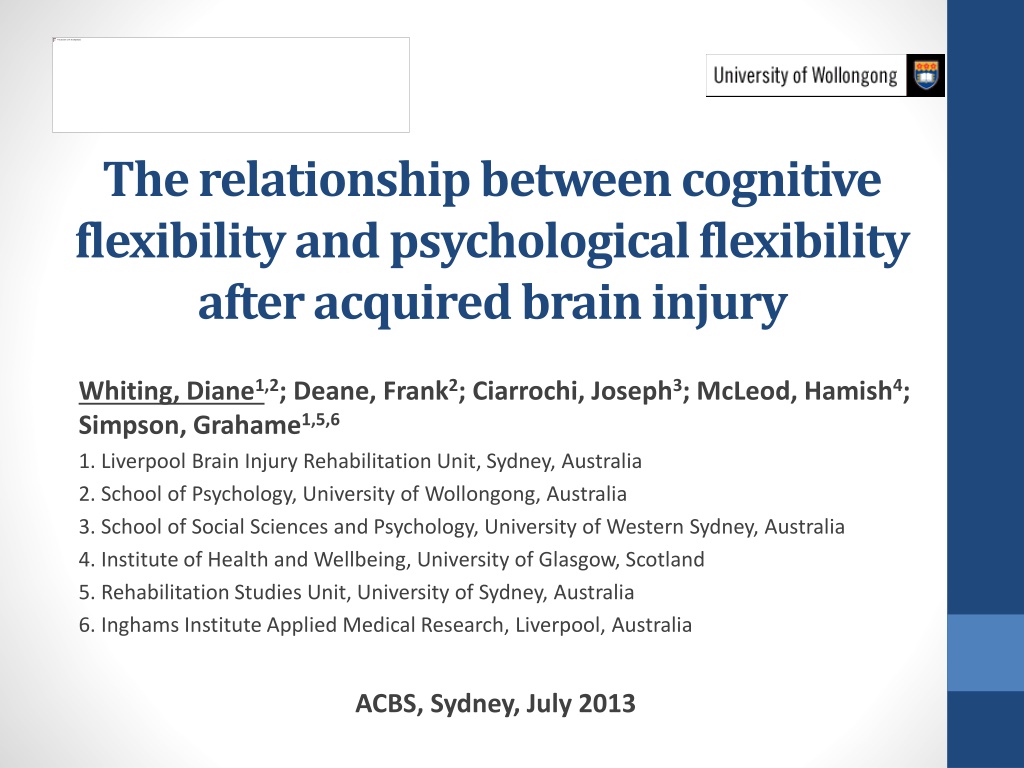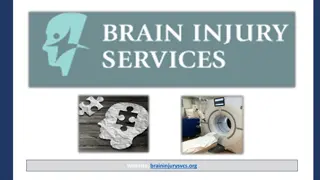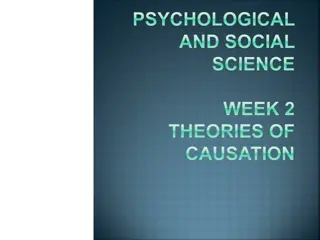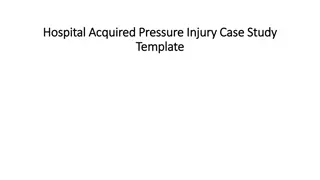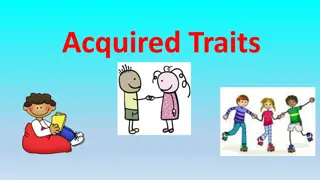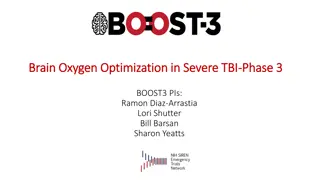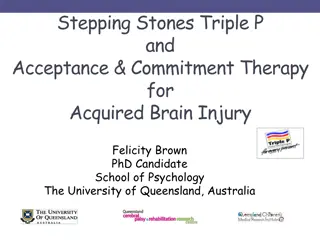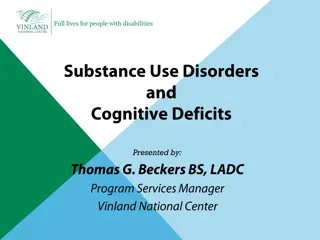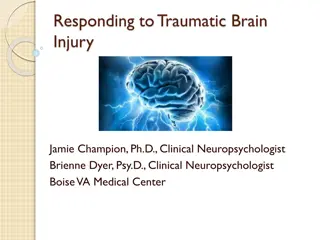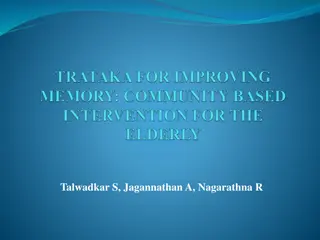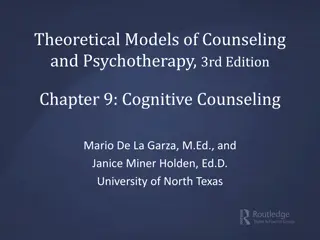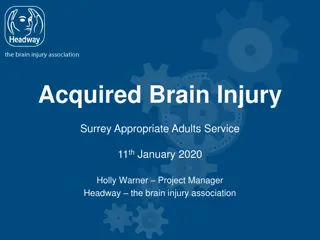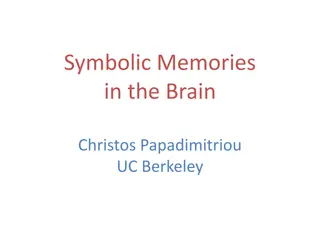The Relationship Between Cognitive Flexibility and Psychological Flexibility After Acquired Brain Injury
This study explores how cognitive flexibility and psychological flexibility interact after an acquired brain injury. It examines whether individuals who exhibit cognitive inflexibility can achieve psychological flexibility, considering the impact of cognitive impairments post-injury. Cognitive flexibility is linked to executive functioning, while psychological flexibility involves staying present and aligning behaviors with personal values. The goal is to enhance psychological flexibility in the context of a values-guided life, particularly in the realm of contextual behavior therapies like ACT.
Download Presentation

Please find below an Image/Link to download the presentation.
The content on the website is provided AS IS for your information and personal use only. It may not be sold, licensed, or shared on other websites without obtaining consent from the author. Download presentation by click this link. If you encounter any issues during the download, it is possible that the publisher has removed the file from their server.
E N D
Presentation Transcript
The relationship between cognitive flexibility and psychological flexibility after acquired brain injury Whiting, Diane1,2; Deane, Frank2; Ciarrochi, Joseph3; McLeod, Hamish4; Simpson, Grahame1,5,6 1. Liverpool Brain Injury Rehabilitation Unit, Sydney, Australia 2. School of Psychology, University of Wollongong, Australia 3. School of Social Sciences and Psychology, University of Western Sydney, Australia 4. Institute of Health and Wellbeing, University of Glasgow, Scotland 5. Rehabilitation Studies Unit, University of Sydney, Australia 6. Inghams Institute Applied Medical Research, Liverpool, Australia ACBS, Sydney, July 2013
Aim Explore the interaction between cognitive flexibility and psychological flexibility after an acquired brain injury Cognitive Flexibility
Why? Psychological flexibility is proposed to be necessary for well being Psychological flexibility desired treatment outcome of contextual behaviour therapies such as ACT A component of psychological flexibility is cognitive flexibility After a brain injury people experience cognitive impairments including impairments in their cognitive flexibility Therefore can those who demonstrate cognitive inflexibility achieve psychological flexibility?
Overlapping Psychological Flexibility Cognitive Flexibility
Is one a component of the other? Psychological Flexibility
Cognitive Flexibility Cognitive flexibility is an aspect of executive functioning It is the ability to change behaviour such as a thought or action in response to situational demands (Lezak, 2004) Individuals with ABI often demonstrated impairments in their executive functioning, including their cognitive flexibility.
Psychological Flexibility Psychological flexibility refers to an individuals ability to stay in contact with the present moment and to change or persist with behaviour that is consistent with their values (Hayes et al., 2006) Component of psychological flexibility is proposed to be cognitive flexibility (Chawla & Ostafin, 2007; Kashdan & Rottenberg, 2010) The goal of ACT is to increase psychological flexibility within the context of a values guided life.
Measures Psychological flexibility Acceptance & Action Questionnaire II (AAQ-II) (Bond et al., 2011) Acceptance & Action Questionnaire Acquired Brain Injury (AAQ-ABI-R) (Sylvester, 2011) Mood Depression Anxiety and Stress Scales 21 (DASS21) Positive and Negative Affect Schedule (PANAS) Appraisal Threat and Avoidance Questionnaire (ATAQ) Cognitive flexibility Similarities (Subtest of WAIS-IV) Wisconsin Card Sort Test (Perseverative errors, failure to maintain set) Trail Making Test (A/B%) Stroop Alternate Uses Test (AUT) COWAT (post hoc)
Participants 75 ABI clients of Liverpool Brain Injury Rehabilitation Unit Inclusion criteria Sustained an acquired brain injury (ABI) after the age of 17 years Aged between 17 and 65 years Adequate language skills & cognitive ability to complete measures Exclusion criteria Malingering on neuropsychological assessment ABI is from a dementia or neurological illness
Demographic Variables Variable Mean (SD)/Number (%) N = 75 Gender - Male - Female 58 (77.3) 17 (22.3) Age 38.7 (14.5) Injury Type - TBI - ABI 58 (77.3) 17 (22.3) PTA (days) (n=58) [median] 24.6 (34.3) [14] Time since injury/dx (months) [median] 20.8 (27.0) [14]
Results Relationships between Psychological flexibility and measures of mood Spearmans Rho (n=75) AAQ-II DASS- Depr DASS- Anx DASS- Stress PANAS -ve PANAS +ve ATAQ- threat ATAQ- Avoid AAQ-ABI 9-item .70** -.67** -.63** -.64** -.74** .35** -.66** -.72** AAQ-II -.66** -.52** -.56** -.72** .33** -.60** -.63** **p < .01; DASS: Depression Anxiety and Stress Scale 21; PANAS: Positive and Negative Affect Schedule; ATAQ: Appraisal Threat and Avoidance Questionnaire
Results Relationships between psychological flexibility and cognitive flexibility Spearmans Rho (n=75) Sim WCST PR WCST FTMS Stroop C/W % Trails A/B % FAS AUT AAQ-ABI 9-item .26* -.21 -.26* .33** .04 .42** .32** AAQ-II .23* -.06 -.08 .28* -.003 .49** .24* **p < .01; *p < .05 Sim: Similarities (WAIS-IV), WCST PR Perseverative Responses, WCST FTMS: Failure to maintain set, Stroop C/W %: Colour Word Percentile, Trails A/B%: Percentage ration between trail A & B, FAS: Controlled Oral Word Associate Test, AUT: Alternate Uses Test.
Results Relationships between psychological flexibility and cognitive flexibility FSIQ (WIAS-IV & III) Spearmans Rho (n=51) AAQ-II Sim WCST PE WCST FTMS Stroop C/W% Trails A/B% FAS AUT AAQ- ABI 9-item .62** NA -.09 ns .35* NA .27 p=.055 .20 ns AAQ-II NA NA .13 ns NA .39** .09 ns **p < .01; * p < .05 Similarities excluded as it is a subtest of WAIS-IV
Results Relationships between psychological flexibility and memory, working memory and processing speed Spearmans Rho (n=51) Arith Coding Symbol CVLT-II 1-5 CVLT Short delay WMS LM I WMS LM II WMS VR I & VRII Search & Digit Span AAQ- ABI 9-item .32* .32* ns .24* ns .27* ns ns AAQ-II .28* .26* ns .30* .25* .27* ns ns p < .05 Working Memory: Arithmetic & Digit Span Processing Speed: Coding & Symbol Search
Results Relationships between psychological flexibility and memory, working memory and processing speed Spearmans Rho Partial correlation with FSIQ (WAIS- IV &III) (n=48) Arith Coding Symbol CVLT-II 1-5 CVLT Short delay WMS LM I WMS LM II WMS VR I & VRII Search & Digit span AAQ-ABI 9-item ns ns ns ns ns AAQ-II ns ns ns ns ns Arithmetic, Coding, Symbol Search & Digit span excluded as all subtests of FSIQ
Results Relationships between psychological flexibility and cognitive flexibility partial correlation with 1. Working memory (Arithmetic) 2. Processing speed (Coding) Spearmans Rho (n=51) 1. Wording Memory (Arithmetic) 2. Processing Speed (Coding) Stroop C/W% FAS Verbal Fluency Stroop C/W% FAS Verbal Fluency AAQ-ABI 9-item .35** .25 .35** .30* AAQ-II .13 ns .34* .13 ns .37** **p < .01; * p < .05
Cognitive Flexibility Psychological Flexibility Accounting for General Intelligence Verbal & Visual Memory Working memory Processing Speed COWAT (FAS) Verbal generativity Stroop C/W Verbal inhibition
Conclusions Components of cognitive flexibility are associated with psychological flexibility A large number of the relationships can be explained by general intelligence The ability to shift a commonly used measure of cognitive flexibility demonstrated no association Higher level verbal flexibility such as verbal generativity and verbal inhibition indicated a moderate positive relationship This association remained even accounting for general intelligence, working memory and processing speed.
Final Message Higher levels of psychological flexibility are associated with good verbal generativity and verbal inhibition Therefore, there does appear to be some overlap between the constructs of cognitive flexibility and psychological flexibility but You don t necessarily have to be cognitively flexible in order to be psychological flexible but it probably helps!
References & Questions Bond, F. W., Hayes, S. C., Baer, R. A., Carpenter, K. C., Guenole, N., Orcutt, H. K., Waltz, T., Zettle, R. D. (2011). Preliminary psychometric properties of the Acceptance and Action Questionnaire II: A revised measure of psychological flexibility and acceptance. Behavior Therapy, 42, 676-688. Chawla, N., & Ostafin, B. (2007). Experiential avoidance as a functional dimensional approach to psychopathology: An empirical review. Journal of Clinical Psychology, 63(9), 871-890. Hayes, S. C., Luoma, J. B., Bond, F. W., Masuda, A., & Lillis, J. (2006). Acceptance and Commitment Therapy: Model, processes, and outcomes. Behaviour Research and Therapy, 44(1), 1-25. Kashdan, T. B., & Rottenberg, J. (2010). Psychological flexibility as a fundamental aspect of health. Clinical Psychology Review, 30(4), 467-480. Lezak, M. D. (2004). Neuropsychological assessment: Oxford University Press, USA. Sylvester, M. (2011). Acceptance and commitment therapy for improving adaptive functioning in persons with a history of pediatric acquired brain injury. Doctor of Philosophy in Clinical Psychology Dissertation, University of Nevada, Reno.
